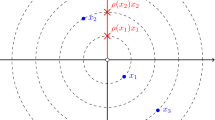Abstract
This paper elaborates the theoretical foundations of a semi-differential framework for invariance. Semi-differential invariants combine coordinates and their derivatives with respect to some contour parameter at several points of the image contour, thus allowing for an optimal trade-off between identification of points and the calculation of derivatives. A systematic way of generating complete and independent sets of such invariants is presented. It is also shown that invariance under reparametrisation can be cast in the same framework. The theory is illustrated by a complete analysis of 2D affine transformations. In a companion paper (Pauwels et al. 1995) these affine semi-differential invariants are implemented in the computer program FORM (Flat Object Recognition Method) for the recognition of planar contours under pseudo-perspective projection.
Similar content being viewed by others
References
Arbter, K., Snyder, W., Burkhardt, H. and Hirzinger, G. 1990. Application of affine invariant Fourier descriptors to recognition of 3D objects,IEEE Trans. on Pattern Anal. and Mach. Intell. PAMI-12 (7): 640–647.
Brill, M.H., Barrett, E.B. and Payton, P.M. 1992. Projective invariants for curves in two and three dimensions. In: Mundy, J. and Zisserman, A. (eds.),Geometric Invariance in Computer Vision. MIT Press: Cambridge, Massachusetts / London, England. Chapter 9: 193–214.
Bruckstein, A. and Netravali, A. 1990. On differential invariants of planar curves and recognizing partially occluded planar shapes, AT&T Technical Report.
Chester, C. R. 1971.Techniques in Partial Differential Equations. International Student Edition, McGraw-Hill Kogakusha, Ltd.
Costa, M., Haralick, R., Phillips, T. and Shapiro, L. 1989. Optimal affine-invariant point matching, SPIE Vol. 1095,Applications of Artificial Intelligence VII, pp. 515–530.
Cyganski, D., Orr, J., Cott, T. and Dodson, R. 1987. Development, implementation, testing, and application of an affine transform invariant curvature function. InProc. 1st Int. Conf. on Computer Vision, pp. 496–500.
Forsyth, D.A., Mundy, J.L. and Zisserman, A.P. 1990.Transformation invariance-A primer. Proc. BMVC'90.
Guggenheimer, H. 1977. Differential Geometry Dover Publications: New York.
Huttenlocher, D.P. and Ullman, S. 1987.Object recognition using Allignment. In:Proc. 1st Int. Conf. on Computer Vision, pp. 102–111.
Kanatani, 1990.Group-Theoretical Methods in Image Understanding. Springer-Verlag, Berlin, New York.
Kempenaers, P., Van Gool, L. and Oosterlinck, A. 1991. Shape recognition under affine distortion. In: Arcelli, C., Cordelia, L., Sannitidi Baja, G. (eds.)Visual Form. Plenum: New York, pp. 323–332.
Lamdan, Y., Schwartz, J. and Wolfson, H. 1988. On recognition of 3-D objects from 2-D images, InProc. IEEE Int. Conf. on Robotics and Automation, pp. 1407–1413.
Moon, P. and Spencer, D.E. 1969:Partial Differential Equations. Heath International Student Edition.
Moons, T., Pauwels, E.J., Van Gool, L.J. and Oosterlinck, A. Jan. 1994.Foundations of semi-Differential Invariance with Applications to Recognition under Affine Distortion. Technical Report KUL/ESAT/MI2/9404. ESAT, Kath. Univ. Leuven.
Mundy, J. and Zisserman, A. (eds.), 1992. Geometric Invariance in Computer Vision MIT Press: Cambridge, Massachusetts / London, England.
Olver, P.J. 1986.Applications of Lie groups to Differential Equations, Graduate Texts in Mathematics, vol. 107. Springer-Verlag: Berlin / Heidelberg / New York / Tokyo.
Pauwels, E.J., Moons, T., Van Gool, L., Kempenaers, P. and Oosterlinck, A. 1995. Recognition of planar shapes under affine distortion. To be published inInternational Journal of Computer Vision, Vol. 14.
Rothwell, C.A., Zisserman, A., Forsyth, D.A. and Mundy, J.L. 1991. Using projective invariants for constant time library indexing in model based vision.Proc. BMVC91, pp. 62–70.
Sagle, A.A. and Walde, R.E. 1973.Introduction to Lie Groups and Lie Algebras. Pure and Applied Mathematics, Vol. 51. Academic Press: New York.
Schutz, B.F. 1980.Geometrical methods in mathematical physics. Cambridge University Press: Cambridge, U.K..
Ullman, S. 1989. Aligning pictorial descriptions: an approach to object recognition. Cognition 32:193–254.
Van Gool, L., Wagemans, J., Vandeneede, J. and Oosterlinck, A. 1990. Similarity extraction and modelling. InProc. 3rd Int. Conf. on Computer Vision, pp. 530–534.
Van Gool, L., Kempenaers, P. and Oosterlinck, A. 1991. Recognition and semi-differential invariants. InIEEE Conf. on Computer Vision and Pattern Recognition, pp. 454–460.
Van Gool, L., Moons, T., Pauwels, E.J. and Oosterlinck, A. 1992, Semi-differential invariants. In: J. Mundy and A. Zisserman (eds.), Geometric Invariance in Computer Vision. MIT Press: Cambridge, Massachusetts / London, England. Chapter 8:157–192.
Van Gool, L., Brill, M., Barrett, E., Moons, T. and Pauwels, E.J. 1992. Semi-differential invariants for nonplanar curves. In: Mundy, J. and Zisserman, A. (eds.) Geometric Invariance in Computer Vision. MIT Press: Cambridge, Massachusetts / London, England Chapter 11: pp. 293–309.
Weiss, I. 1988. Projective invariants of shapes,Proc. Int. Conf. on Computer Vision and Pattern Recognition, pp. 291–297.
Weiss, I. 1991. Noise-Resistant Invariants of Curves,Proc. of the first DARPA / ESPRIT Workshop on Invariants, Rejkjavic, Iceland, March 1991, pp. 319–344.
Weiss, I. 1991. Robustness of Algebraic Invariants,Proc. of the first DARPA / ESPRIT Workshop on Invariants, Rejkjavic, Iceland, March, 1991, pp. 345–357.
Weiss, I. 1992. Noise-Resistant Invariants of Curves, In: Mundy, J. and Zisserman, A. (eds.), Geometric Invariance in Computer Vision. MIT Press: Cambridge, Massachusetts / London, England. Chapter 7:135–156.
Weyl, H. 1966.The Classical Groups and their Invariants and Representations. Princeton University Press.
Author information
Authors and Affiliations
Additional information
Post-doctoral Research Fellow of the Belgian National Fund for Scientific Research (N.F.W.O.).
Rights and permissions
About this article
Cite this article
Moons, T., Pauwels, E.J., Van Gool, L.J. et al. Foundations of semi-differential invariants. Int J Comput Vision 14, 25–47 (1995). https://doi.org/10.1007/BF01421487
Received:
Revised:
Issue Date:
DOI: https://doi.org/10.1007/BF01421487




